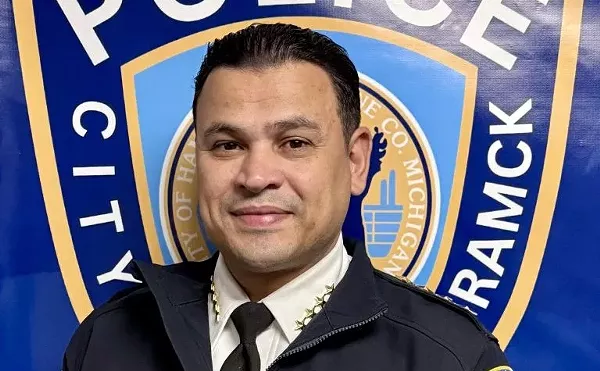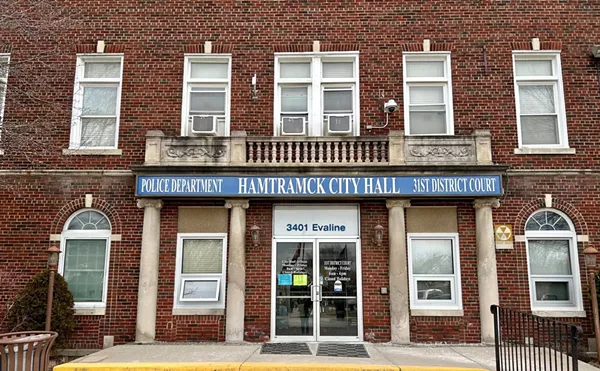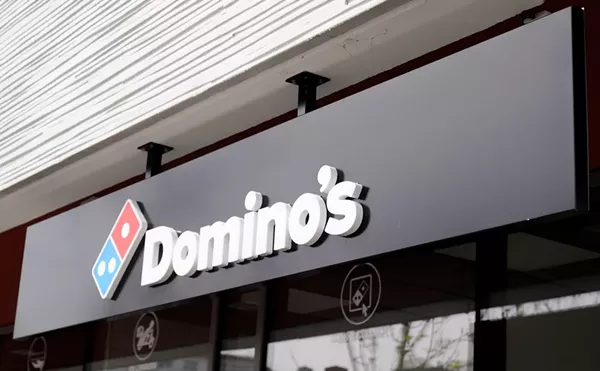
Audio By Carbonatix
[
{
"name": "GPT - Leaderboard - Inline - Content",
"component": "35519556",
"insertPoint": "5th",
"startingPoint": "3",
"requiredCountToDisplay": "3",
"maxInsertions": 100,
"adList": [
{
"adPreset": "LeaderboardInline"
}
]
}
]
Metro Detroit was introduced this weekend to Detroiter James Robertson, a guy with a grind so remarkable, it makes anyone who complains about their daily commute look like a fool: As described by Bill Laitner of the Detroit Free Press, Robertson wakes up at 6 a.m. every day; walks to a bus stop at Woodward and Holbrook by 8 a.m.; takes a SMART bus to Somerset Mall; gets off and walks to Crooks Road; then heads north for seven miles to his job at a factory in Rochester Hills near M-59. His shift begins at 2 p.m., only eight hours after he began his trek.
It doesn't stop there: Once his day is over, he heads back to Somerset Collection — another seven miles — to catch the last SMART bus headed south on Woodward. He arrives at the State Fairgrounds around 1:35 a.m., and then, instead of waiting for a Detroit Department of Transportation (DDOT) transfer bus (a task that can itself last forever), he walks another five miles to his house. He arrives home at 4 a.m., sleeps for two hours, and starts all over again. (At the very least, he has some downtime to snooze on the bus?)
"I sleep a lot on the weekend, yes I do," he tells Laitner.
This is insane. Stories abound of Detroiters having to endure piss-poor transit options — e.g., I once interviewed a woman who says a two-hour wait for a bus isn't unusual — but Robertson's story is on another level. The 56-year-old's car took a dive about a decade ago, and he hasn't been able to purchase a new one since. So he walks.
And while it's heartening to see hundreds of people step up to help Robertson out, there's a larger discussion to be had here — nothing a GoFundMe campaign can articulate. (The Freep's Stephen Henderson makes this point in a great piece this morning.)
Robertson, the woman who waits two-hours for a bus, the inability of SMART to relaunch service into Detroit at all hours due to a lack of funding: This shouldn't be acceptable to anyone. And yet, it's been the same story we've heard for decades. We say we want to improve transit options for everyone in metro Detroit, we've just failed to execute a plan to do so. As Henderson pointed out, one of the many significant hindrances as to why legislators haven't been able to construct a seamless transit system here has to do with policies that dictate the SMART bus system. Cities like Rochester Hills and Livonia have the ability to "opt-out" from participating in the system, and gladly choose to. I've said this on many occasions in the past: It would be nice to visit my folks in Livonia without a car, except that would require taking a DDOT route that includes three transfers and would last nearly two-and-a-half-hours. All that, to travel some 10 miles. What that creates is a porous network for the roughly 135,000 SMART and DDOT riders, like Roberston, who can't access destinations they need to reach each day with relative ease. Again: this is insane.
Stories like these should grab the attention of local officials and legislators in Lansing by their shirt-collars and shake them madly, but the truth is, it probably won't. Coupled with the Freep's demonstration of how disconnected our transit options are for non-motorists was a story about the Michigan Department of Transportation's inability so far to launch a commuter rail service between Howell and Ann Arbor, as well as Ann Arbor and Detroit. While transit reps sit idly, waiting for legislators to find money to get even a limited service up-and-running, we're spending over $1 million to lease 23 rail cars that go unused. You can almost hear the outstate legislators yammering from here.
That may get a comment section of trolls shrieking foul, but what it should do is serve as a call for change. For too long, the response to public transit in Michigan has been a relatively divisive approach. No one agrees on anything, so it essentially ends up being a hands-off effort. There's probably not a better example to illustrate that point than what has taken place since the Southeast Regional Transit Authority launched. Rather than create an entity that had sufficient funding to land its first pick as CEO, RTA officials were essentially goaded into prying funds out from the legislature just to get its operation rolling.
Now, with an upcoming ballot question in May that would fund road repairs through a sales tax increase, the RTA faces an uphill battle to gather an affirmative vote in November 2016, when voters will be asked to spend more for transit. And yet there's still potential mishaps in the making, for instance, a Republican state representative's desire to implement a similar opt-out policy for the RTA — something that would gut the authority's ability to succeed. Do we actually want better transit options in metro Detroit?
The point is this: There are more James Robertsons out there. The majority don't endure the type of incredible daily grind he does, but they still have to deal with the hellish enterprise that is metro Detroit public transit. We all know this. But without any additional funding in the future, chances are we'll continue to hear more stories of a similar nature for years — nay, decades — to come.
____________________________________
Update (4:30 p.m.): A comment on social media reminded of a section from last year's MT cover story titled, "How metro Detroit ended up with the worst public transit." It's likely the region's dependence on the auto industry played some role in constructing our modern day system, but it's rather remarkable to think that in the 1920s, voters had the opportunity to approve a subway line that would've run from Detroit to Ford Motor Co.'s Rouge Complex — and it was supported by automakers. The proposal, in the end, failed. As described by Joel Batterman, policy director for Detroit faith-based group MOSES in an article for Progressive Planning magazine:
In his piece, Batterman cites a historian who said the subway proposal garnered the most support in the black ghetto, where workers needed transit to reach their jobs.
It doesn't stop there: Once his day is over, he heads back to Somerset Collection — another seven miles — to catch the last SMART bus headed south on Woodward. He arrives at the State Fairgrounds around 1:35 a.m., and then, instead of waiting for a Detroit Department of Transportation (DDOT) transfer bus (a task that can itself last forever), he walks another five miles to his house. He arrives home at 4 a.m., sleeps for two hours, and starts all over again. (At the very least, he has some downtime to snooze on the bus?)
"I sleep a lot on the weekend, yes I do," he tells Laitner.
This is insane. Stories abound of Detroiters having to endure piss-poor transit options — e.g., I once interviewed a woman who says a two-hour wait for a bus isn't unusual — but Robertson's story is on another level. The 56-year-old's car took a dive about a decade ago, and he hasn't been able to purchase a new one since. So he walks.
And while it's heartening to see hundreds of people step up to help Robertson out, there's a larger discussion to be had here — nothing a GoFundMe campaign can articulate. (The Freep's Stephen Henderson makes this point in a great piece this morning.)
Robertson, the woman who waits two-hours for a bus, the inability of SMART to relaunch service into Detroit at all hours due to a lack of funding: This shouldn't be acceptable to anyone. And yet, it's been the same story we've heard for decades. We say we want to improve transit options for everyone in metro Detroit, we've just failed to execute a plan to do so. As Henderson pointed out, one of the many significant hindrances as to why legislators haven't been able to construct a seamless transit system here has to do with policies that dictate the SMART bus system. Cities like Rochester Hills and Livonia have the ability to "opt-out" from participating in the system, and gladly choose to. I've said this on many occasions in the past: It would be nice to visit my folks in Livonia without a car, except that would require taking a DDOT route that includes three transfers and would last nearly two-and-a-half-hours. All that, to travel some 10 miles. What that creates is a porous network for the roughly 135,000 SMART and DDOT riders, like Roberston, who can't access destinations they need to reach each day with relative ease. Again: this is insane.
Stories like these should grab the attention of local officials and legislators in Lansing by their shirt-collars and shake them madly, but the truth is, it probably won't. Coupled with the Freep's demonstration of how disconnected our transit options are for non-motorists was a story about the Michigan Department of Transportation's inability so far to launch a commuter rail service between Howell and Ann Arbor, as well as Ann Arbor and Detroit. While transit reps sit idly, waiting for legislators to find money to get even a limited service up-and-running, we're spending over $1 million to lease 23 rail cars that go unused. You can almost hear the outstate legislators yammering from here.
That may get a comment section of trolls shrieking foul, but what it should do is serve as a call for change. For too long, the response to public transit in Michigan has been a relatively divisive approach. No one agrees on anything, so it essentially ends up being a hands-off effort. There's probably not a better example to illustrate that point than what has taken place since the Southeast Regional Transit Authority launched. Rather than create an entity that had sufficient funding to land its first pick as CEO, RTA officials were essentially goaded into prying funds out from the legislature just to get its operation rolling.
Now, with an upcoming ballot question in May that would fund road repairs through a sales tax increase, the RTA faces an uphill battle to gather an affirmative vote in November 2016, when voters will be asked to spend more for transit. And yet there's still potential mishaps in the making, for instance, a Republican state representative's desire to implement a similar opt-out policy for the RTA — something that would gut the authority's ability to succeed. Do we actually want better transit options in metro Detroit?
The point is this: There are more James Robertsons out there. The majority don't endure the type of incredible daily grind he does, but they still have to deal with the hellish enterprise that is metro Detroit public transit. We all know this. But without any additional funding in the future, chances are we'll continue to hear more stories of a similar nature for years — nay, decades — to come.
____________________________________
Update (4:30 p.m.): A comment on social media reminded of a section from last year's MT cover story titled, "How metro Detroit ended up with the worst public transit." It's likely the region's dependence on the auto industry played some role in constructing our modern day system, but it's rather remarkable to think that in the 1920s, voters had the opportunity to approve a subway line that would've run from Detroit to Ford Motor Co.'s Rouge Complex — and it was supported by automakers. The proposal, in the end, failed. As described by Joel Batterman, policy director for Detroit faith-based group MOSES in an article for Progressive Planning magazine:
“[The subway] met fierce opposition from the homeowners’ organizations that also held the line against neighborhood racial integration ... The subway would serve the automakers and downtown businesses, they argued, at the expense of the expanding middle class, which inhabited the city’s vast tracts of new single-family homes and no longer relied on Detroit’s extensive but slow streetcar system.”
In his piece, Batterman cites a historian who said the subway proposal garnered the most support in the black ghetto, where workers needed transit to reach their jobs.






